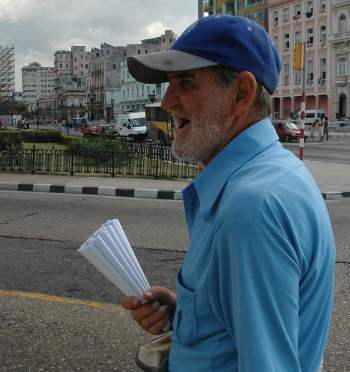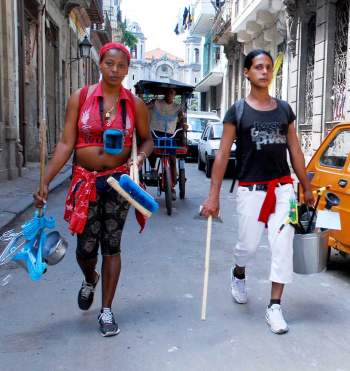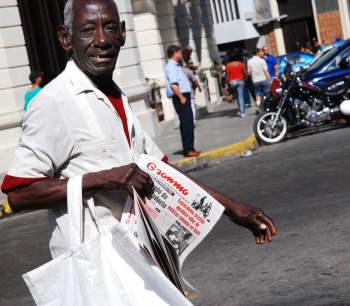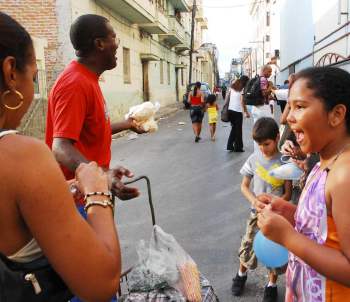The Musicality of Cuba’s Streets
Irina Echarry, Photos: Caridad
 HAVANA TIMES, April 22 — Humorous, clever, serious, some more melodious than others, they surprise us in their daily routines. Their products are carried in wheelbarrows and sacks or on bicycles with the vendor walking alongside.
HAVANA TIMES, April 22 — Humorous, clever, serious, some more melodious than others, they surprise us in their daily routines. Their products are carried in wheelbarrows and sacks or on bicycles with the vendor walking alongside.
Of any age, they roam the streets back and forth hawking in season fruits, pointing out the benefits of lemons, flattering women so they buy the best avocados or improvise verses to sell some garlic.
He was walking around in Santiago de Cuba to the rhythm of the city’s sounds when Felix de la Nuez decided to make this documentary. He was motivated to make “Por el pico diverter” on the musicality of the street cries.

 Various Cuban cultural figures such as Luis Carbonell, Miguel Barnet and a few historians from the city of Santiago remind us that the vendor’s cry has been known on the island since the early colonial times.
Various Cuban cultural figures such as Luis Carbonell, Miguel Barnet and a few historians from the city of Santiago remind us that the vendor’s cry has been known on the island since the early colonial times.
Moreover, the act of shouting and singing to indicate that merchandise is being sold has become a tradition.
 With only a few changes over time, which has depended on the creativity and artfulness of street vendors, this practice has survived up through the present day.
With only a few changes over time, which has depended on the creativity and artfulness of street vendors, this practice has survived up through the present day.
 With these characters as the protagonists, the camera picks up fragments of Santiago life, reflecting everything from eating habits to daily machismo (women are the ones who buy food, so the street cries are directed at them).
With these characters as the protagonists, the camera picks up fragments of Santiago life, reflecting everything from eating habits to daily machismo (women are the ones who buy food, so the street cries are directed at them).
 In particular, “Santiagueros” infuse a special grace into these natural expressions using rhythmic elements typical of the inhabitants of this eastern region of the country.
In particular, “Santiagueros” infuse a special grace into these natural expressions using rhythmic elements typical of the inhabitants of this eastern region of the country.
The cries and those criers were the inspiration behind dramatizations in Cuban comic theater and have inspired musical compositions such as “Frutas del Caney,” by Felix B. Cagnet; “El Frutero,” by Lecuona; and “El Manisero,” by Moses Simons, which is where the title of the documentary came from: “If you’re looking for a good little time (por el pico diverter), buy yourself a paper cone full of peanuts.”
It was a good idea of that director to capture this slice of Cuban folklore on film; it’s another way to contribute to the conservation of this facet of popular culture.







I too have one particular fond memory of street vendors. We always look forward to a short stay in the Hotel Colon in Camaguey. Being early rises, we were on the balcony at 5 am when the bread vendor rolled up with his horse and cart and stopped outside the entrance to the Hotel (directly below our balcony).
The horse was hobbled whilst the vendor sold his baskets of bread. Despite it still being dark, it was a truly memorable moment. We shall be returning there in approximately 4 weeks time and hopefully will experience the sight of the hobbled horse and the muffled cry from the bread vendor.
I thought I was falling in love the man who would yell out “Pan Suave !” every afternoon. And I developed a small friendship with “huevo….huevo…huevoooo” after he saved my life by selling me a dozen eggs 🙂
I will always remember the melodious calls of the street vendors of my youth, during my very first trip to Cuba, in the Summer of 1959! Most mornings I’d wake up to the aroma of brewing coffee and the songs of the street vendors. I’d throw open my shuttered windows–on the sixth or seventh floor of the then broken-down, now non-existent, Hotel Roosevelt, corner of Amistad y San Miguel, Centro–and look down to see a neighbor hauling up a basket of fruit or bread to her balcony on the other side of the Calle San Miguel. More than fifty years have passed since then, but during my visits in 2004, 2006, 2008 and just this past December, i have again been regaled by these wonderful morning cantatas, in Santiago, Bayamo, Vieja (the unrestored part) and in La Lisa/Arroyo Arena. Thanks, Irina and Caridad, for being the catalysts for my memories!